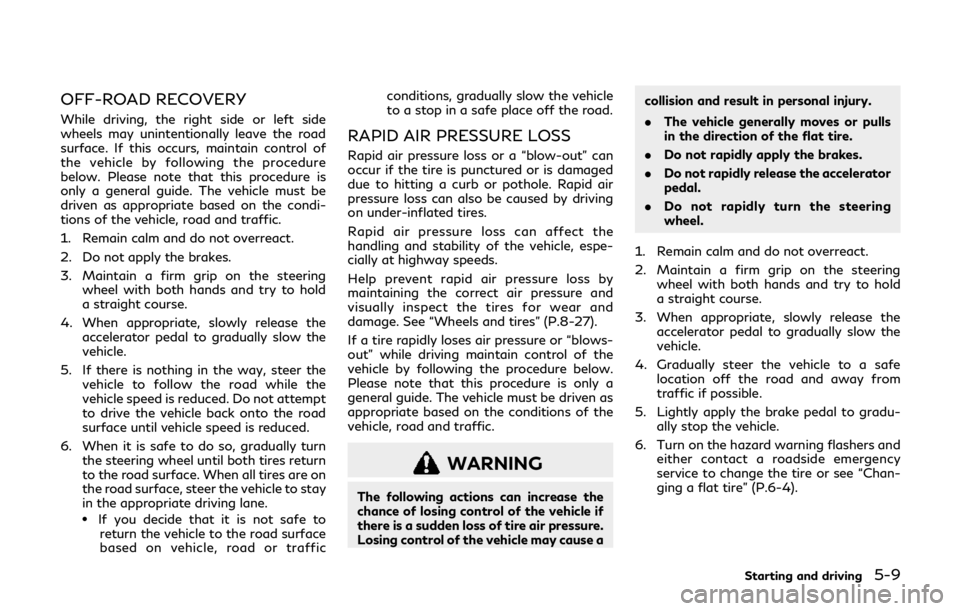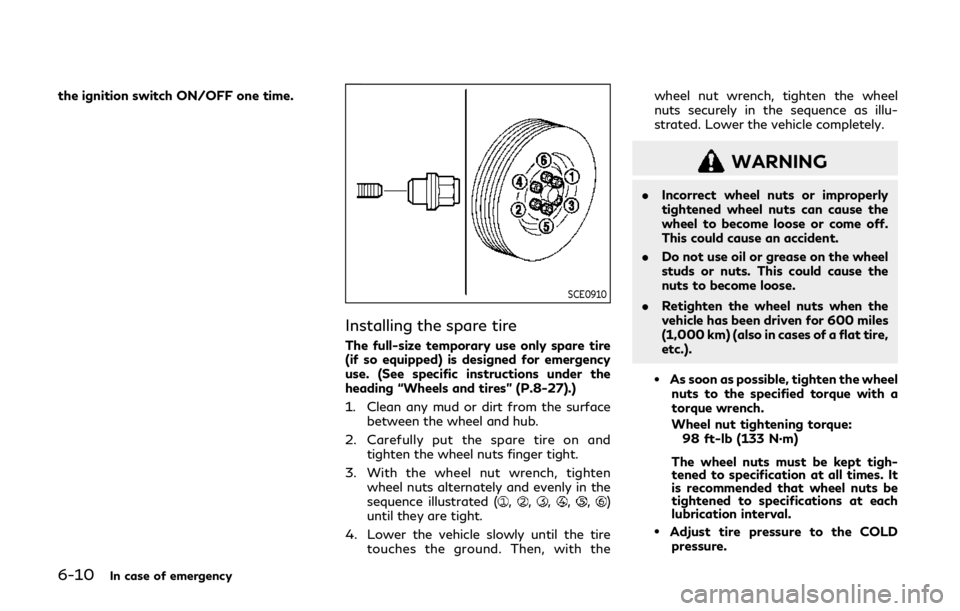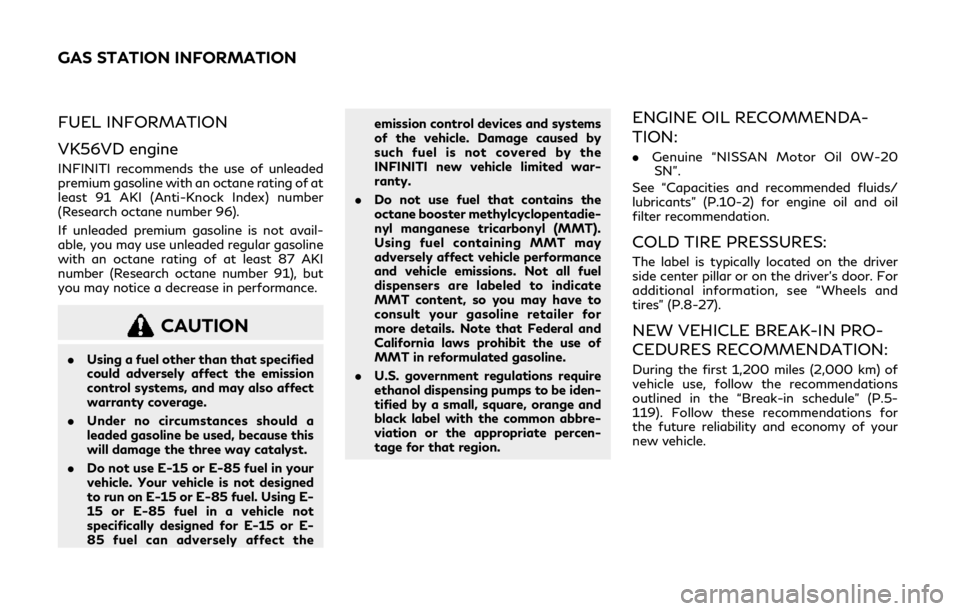8-27 INFINITI QX80 2019 Owner's Manual
[x] Cancel search | Manufacturer: INFINITI, Model Year: 2019, Model line: QX80, Model: INFINITI QX80 2019Pages: 524, PDF Size: 2.45 MB
Page 11 of 524

JVC1126X
1. Hood (P.3-21)
2. Windshield wiper and washer— Switch operation (P.2-33)
— Rain-sensing auto wiper system
(P.2-35)
— Wiper blade replacement (P.8-16) — Window washer fluid (P.8-10)
3. Moonroof (P.2-64)
4. Power windows (P.2-61)
5. Roof rack (P.2-60)
6. Towing hook (P.6-18)
7. Front view camera (P.4-3) 8. Sensors
— Camera aiding sonar function
(P.4-16)
9. Headlight washers (if so equipped) (P.2-42)
10. Fog light (P.2-44)
11. Headlight (P.2-37) — Adaptive Front lighting System
(AFS) (if so equipped) (P.2-42)
12. Front parking light/daytime running light/front turn signal light (P.2-37)
13. Tires — Wheel and tires (P.8-27, P.10-9)
— Flat tire (P.6-3)
— Tire Pressure Monitoring System
(TPMS) (P.2-15, P.5-5)
14. Outside mirrors (P.3-37) — Side view camera (P.4-3)
— Welcome light (P.2-65)
15. Side turn signal lights (P.8-23)
16. Doors — Keys (P.3-2)
— Door locks (P.3-4)
— Intelligent Key system (P.3-7)
— Remote keyless entry system
(P.3-15)
— Remote engine start (if so equipped)
(P.3-19)
Illustrated table of contents0-3
EXTERIOR FRONT
Page 259 of 524

OFF-ROAD RECOVERY
While driving, the right side or left side
wheels may unintentionally leave the road
surface. If this occurs, maintain control of
the vehicle by following the procedure
below. Please note that this procedure is
only a general guide. The vehicle must be
driven as appropriate based on the condi-
tions of the vehicle, road and traffic.
1. Remain calm and do not overreact.
2. Do not apply the brakes.
3. Maintain a firm grip on the steeringwheel with both hands and try to hold
a straight course.
4. When appropriate, slowly release the accelerator pedal to gradually slow the
vehicle.
5. If there is nothing in the way, steer the vehicle to follow the road while the
vehicle speed is reduced. Do not attempt
to drive the vehicle back onto the road
surface until vehicle speed is reduced.
6. When it is safe to do so, gradually turn the steering wheel until both tires return
to the road surface. When all tires are on
the road surface, steer the vehicle to stay
in the appropriate driving lane.
.If you decide that it is not safe toreturn the vehicle to the road surface
based on vehicle, road or traffic conditions, gradually slow the vehicle
to a stop in a safe place off the road.
RAPID AIR PRESSURE LOSS
Rapid air pressure loss or a “blow-out” can
occur if the tire is punctured or is damaged
due to hitting a curb or pothole. Rapid air
pressure loss can also be caused by driving
on under-inflated tires.
Rapid air pressure loss can affect the
handling and stability of the vehicle, espe-
cially at highway speeds.
Help prevent rapid air pressure loss by
maintaining the correct air pressure and
visually inspect the tires for wear and
damage. See “Wheels and tires” (P.8-27).
If a tire rapidly loses air pressure or “blows-
out” while driving maintain control of the
vehicle by following the procedure below.
Please note that this procedure is only a
general guide. The vehicle must be driven as
appropriate based on the conditions of the
vehicle, road and traffic.
WARNING
The following actions can increase the
chance of losing control of the vehicle if
there is a sudden loss of tire air pressure.
Losing control of the vehicle may cause a
collision and result in personal injury.
.
The vehicle generally moves or pulls
in the direction of the flat tire.
. Do not rapidly apply the brakes.
. Do not rapidly release the accelerator
pedal.
. Do not rapidly turn the steering
wheel.
1. Remain calm and do not overreact.
2. Maintain a firm grip on the steering wheel with both hands and try to hold
a straight course.
3. When appropriate, slowly release the accelerator pedal to gradually slow the
vehicle.
4. Gradually steer the vehicle to a safe location off the road and away from
traffic if possible.
5. Lightly apply the brake pedal to gradu- ally stop the vehicle.
6. Turn on the hazard warning flashers and either contact a roadside emergency
service to change the tire or see “Chan-
ging a flat tire” (P.6-4).
Starting and driving5-9
Page 382 of 524

5-132Starting and driving
to skid and result in an accident.
. If the engine is not running or is
turned off while driving, the power
assist for the brakes will not work.
Braking will be harder.BRAKE ASSIST
When the force applied to the brake pedal
exceeds a certain level, the Brake Assist is
activated generating greater braking force
than a conventional brake booster even with
light pedal force.
WARNING
The Brake Assist is only an aid to assist
braking operation and is not a collision
warning or avoidance device. It is the
driver’s responsibility to stay alert, drive
safely and be in control of the vehicle at
all times.
ANTI-LOCK BRAKING SYSTEM
(ABS)
WARNING
.The Anti-lock Braking System (ABS)
is a sophisticated device, but it
cannot prevent accidents resulting
from careless or dangerous driving
techniques. It can help maintain ve-
hicle control during braking on slip-
pery surfaces. Remember that
stopping distances on slippery sur- faces will be longer than on normal
surfaces even with ABS. Stopping
distances may also be longer on
rough, gravel or snow covered roads,
or if you are using tire chains. Always
maintain a safe distance from the
vehicle in front of you. Ultimately,
the driver is responsible for safety.
. Tire type and condition may also
affect braking effectiveness.
— When replacing tires, install the specified size of tires on all four
wheels.
— When installing a spare tire, make sure that it is the proper size and
type as specified on the Tire and
Loading Information label. See
“Tire and loading information la-
bel” (P.10-13).
— For detailed information, see “Wheels and tires” (P.8-27).
The Anti-lock Braking System (ABS) controls
the brakes so the wheels do not lock during
hard braking or when braking on slippery
surfaces. The system detects the rotation
speed at each wheel and varies the brake
fluid pressure to prevent each wheel from
locking and sliding. By preventing each
wheel from locking, the system helps the
BRAKE ASSIST
Page 398 of 524

6-10In case of emergency
the ignition switch ON/OFF one time.
SCE0910
Installing the spare tire
The full-size temporary use only spare tire
(if so equipped) is designed for emergency
use. (See specific instructions under the
heading “Wheels and tires” (P.8-27).)
1. Clean any mud or dirt from the surfacebetween the wheel and hub.
2. Carefully put the spare tire on and tighten the wheel nuts finger tight.
3. With the wheel nut wrench, tighten wheel nuts alternately and evenly in the
sequence illustrated (
,,,,,)
until they are tight.
4. Lower the vehicle slowly until the tire touches the ground. Then, with the wheel nut wrench, tighten the wheel
nuts securely in the sequence as illu-
strated. Lower the vehicle completely.
WARNING
.
Incorrect wheel nuts or improperly
tightened wheel nuts can cause the
wheel to become loose or come off.
This could cause an accident.
. Do not use oil or grease on the wheel
studs or nuts. This could cause the
nuts to become loose.
. Retighten the wheel nuts when the
vehicle has been driven for 600 miles
(1,000 km) (also in cases of a flat tire,
etc.).
.As soon as possible, tighten the wheel
nuts to the specified torque with a
torque wrench.
Wheel nut tightening torque: 98 ft-lb (133 N·m)
The wheel nuts must be kept tigh-
tened to specification at all times. It
is recommended that wheel nuts be
tightened to specifications at each
lubrication interval.
.Adjust tire pressure to the COLD pressure.
Page 399 of 524

COLD pressure:
After the vehicle has been parked for
three hours or more or driven less
than 1 mile (1.6 km).
COLD tire pressures are shown on
the Tire and Loading Information
label affixed to the driver side center
pillar.
After adjusting tire pressure to the COLD
tire pressure, the display of the tire pressure
information may show higher pressure than
the COLD tire pressure after the vehicle has
been driven more than 1 mile (1.6 km). This is
because the tire pressurizes as the tire
temperature rises. This does not indicate a
system malfunction.
Stowing the damaged tire and tools
1. Securely store the damaged tire, jack and tools in the storage area.
2. Close the cargo floor cover.
3. Replace the cargo floor board.
4. Close the liftgate.
WARNING
. Always make sure that the spare tire
and jacking equipment are properly
secured after use. Such items can
become dangerous projectiles in an accident or sudden stop.
. The full-size temporary use only
spare tire (if so equipped) is designed
for emergency use. (See specific in-
structions under the heading “Wheels
and tires” (P.8-27).) To start your engine with a booster battery,
the instructions and precautions below must
be followed.
WARNING
.
If done incorrectly, jump starting can
lead to a battery explosion, resulting
in severe injury or death. It could also
damage your vehicle.
. Explosive hydrogen gas is always
present in the vicinity of the battery.
Keep all sparks and flames away from
the battery.
. Do not allow battery fluid to come
into contact with eyes, skin, clothing
or painted surfaces. Battery fluid is a
corrosive sulphuric acid solution
which can cause severe burns. If the
fluid should come into contact with
anything, immediately flush the con-
tacted area with water.
. Keep the battery out of the reach of
children.
. The booster battery must be rated at
12 volts. Use of an improperly rated
battery can damage your vehicle.
. Whenever working on or near a
battery, always wear suitable eye
protectors (for example, goggles or
In case of emergency6-11
JUMP STARTING
Page 419 of 524

8 Do-it-yourself
Maintenance precautions ............................................... 8-2
Engine compartment check locations ......................... 8-3VK56VD engine model .............................................. 8-3
Engine cooling system ..................................................... 8-4 Checking engine coolant level ................................. 8-5
Changing engine coolant .......................................... 8-5
Engine oil ........................................................................\
..... 8-6 Checking engine oil level ........................................... 8-6
Changing engine oil and filter .................................. 8-6
Automatic Transmission Fluid (ATF) .......................... 8-8
Power steering fluid ......................................................... 8-8
Brake fluid ........................................................................\
... 8-9 Brake fluid .................................................................. 8-10
Window washer fluid ................................................... 8-10
Battery ........................................................................\
....... 8-11 Jump starting ............................................................. 8-13
Variable voltage control system ................................. 8-13
Drive belts ........................................................................\
. 8-13
Spark plugs ....................................................................... 8-14 Replacing spark plugs .............................................. 8-14
Air cleaner ........................................................................\
. 8-15 Windshield wiper blades .............................................. 8-16
Cleaning ..................................................................... 8-16
Replacing ................................................................... 8-16
Rear window wiper blades .......................................... 8-17
Brakes ........................................................................\
........ 8-17 Self-adjusting brakes ............................................. 8-17
Brake pad wear warning ....................................... 8-17
Brake booster ........................................................... 8-17
Fuses ........................................................................\
.......... 8-18 Engine compartment .............................................. 8-18
Passenger compartment ...................................... 8-20
Intelligent Key battery replacement ......................... 8-21
Lights ........................................................................\
......... 8-23
Headlights ................................................................ 8-24
Exterior and interior lights ................................... 8-24
Wheels and tires ............................................................. 8-27
Tire pressure ............................................................. 8-27
Tire labeling .............................................................. 8-31
Types of tires ........................................................... 8-33
Tire chains ................................................................. 8-33
Changing wheels and tires .................................. 8-34
Page 445 of 524

SDI2032
Vanity mirror lightIf you have a flat tire, see “Flat tire” (P.6-3).
TIRE PRESSURE
Tire Pressure Monitoring System
(TPMS)
This vehicle is equipped with the Tire
Pressure Monitoring System (TPMS). It
monitors tire pressure of all tires except the
spare. When the low tire pressure warning
light is lit and the CHECK TIRE PRESSURE
warning appears in the vehicle information
display, one or more of your tires is sig-
nificantly under-inflated.
The TPMS will activate only when the
vehicle is driven at speeds above 16 MPH
(25 km/h). Also, this system may not detect
a sudden drop in tire pressure (for example, a
flat tire while driving).
For more details, see “Low tire pressure
warning light” (P.2-15), “Tire Pressure Mon-
itoring System (TPMS)” (P.5-5) and “Tire
Pressure Monitoring System (TPMS) ” (P.6-
3).
Tire inflation pressure
Check the pressure of the tires (in-
cluding the spare) often and always
prior to long distance trips. The
recommended tire pressure specifica-
tions are shown on the Tire and Loading Information label under the
“Cold Tire Pressure” heading. The Tire
and Loading Information label is
affixed to the driver side center pillar.
Tire pressures should be checked
regularly because:
.
Most tires naturally lose air over
time.
. Tires can lose air suddenly when
driven over potholes or other ob-
jects or if the vehicle strikes a curb
while parking.
The tire pressures should be checked
when the tires are cold. The tires are
considered COLD after the vehicle
has been parked for 3 or more hours,
or driven less than 1 mile (1.6 km) at
moderate speeds.
TPMS with Tire Inflation Indicator
provides visual and audible signals
outside the vehicle for inflating the
tires to the recommended COLD tire
pressure. (See “TPMS with Tire Infla-
tion Indicator” (P.5-7) about the
TPMS with Tire Inflation Indicator.)
Incorrect tire pressure, including un-
der inflation, may adversely affect
Do-it-yourself8-27
WHEELS AND TIRES
Page 515 of 524

Supplemental air bag warning light .... 1-69, 2-17
Supplemental restraint system ........................ 1-52Precautions on supplemental
restraint system ............................................. 1-52
Switch Autolight switch ............................................. 2-37
Fog light switch ............................................ 2-44
Hazard warning flasher switch .................... 6-2
Headlight aiming control ............................. 2-41
Headlight switch ............................................ 2-37
Ignition switch ................................................ 5-18
Power door lock switch ................................. 3-5
Snow mode switch ........................................ 2-49
Turn signal switch ........................................ 2-44
Vehicle dynamic control (VDC)
off switch ........................................................ 2-50
T
Tachometer ............................................................. 2-8
Temperature gauge, Engine coolant
temperature gauge ............................................... 2-8
Theft (INFINITI Vehicle Immobilizer System),
Engine start ........................................................... 2-32
Three-way catalyst ............................................... 5-4
Tilt/telescopic steering ...................................... 3-29
TirePressure, Low tire pressure
warning light ................................................... 2-15
Tire replacement indicator .......................... 2-27
Tires
Flat tire ............................................................... 6-3 Low tire pressure warning system ............. 5-5
Tire and Loading
information label ............................. 8-29, 10-13
Tire chains ........................................................ 8-33
Tire dressing ...................................................... 7-4
Tire pressure ................................................... 8-27
Tire pressure monitoring
system (TPMS) ........................................ 5-5, 6-3
Tire rotation ................................................... 8-34
Types of tires .................................................. 8-33
Uniform tire quality grading .................... 10-30
Wheel/tire size ............................................... 10-9
Wheels and tires ............................................ 8-27
Top Tether strap child restraints ....................... 1-36
TOW mode ......................................................... 5-130
TOW mode switch .............................................. 2-50
Towing Flat towing ................................................... 10-30
Tow truck towing .......................................... 6-15
Towing a trailer ........................................... 10-18
Towing safety .............................................. 10-22
TPMS, Tire pressure monitoring system ......... 5-5 TPMS with Tire Inflation Indicator ............. 5-7
TPMS, Tire pressure warning system .............. 6-3
Trailer towing .................................................... 10-18
Transceiver HomeLink
®
Universal Transceiver ....................... 2-69, 2-73
Transmission
Automatic Transmission Fluid (ATF) ......... 8-8 Driving with automatic transmission ....... 5-18
Transmission shift lever lock release ....... 5-21
Transmitter (See remote keyless
entry system) ........................................................ 3-15
Traveling or registering your vehicle in
another country ................................................. 10-11
Trip computer ....................................................... 2-28
Trip odometer ....................................................... 2-29
Turn signal switch ............................................... 2-44
U
Underbody cleaning ............................................... 7-3
Uniform tire quality grading .......................... 10-30
USB (Universal Serial Bus)
charging connector ............................................. 2-53
V
Vanity mirror ......................................................... 3-39
Vanity mirror lights ............................................. 2-68
Variable voltage control system ..................... 8-13
Vehicle Dimensions ................................................... 10-10
Identification number (VIN) ...................... 10-11
Loading information .................................. 10-14
Recovery (freeing a stuck vehicle) ............ 6-18
Security system .............................................. 2-31
Vehicle dynamic control (VDC)
off switch ........................................................ 2-50
Vehicle dynamic control
(VDC) system ................................................ 5-133
11-7
Page 516 of 524

11-8
Vehicle dynamic control (VDC)
warning light ................................................... 2-18
Vehicle information display .............................. 2-21
Ventilators ............................................................. 4-25
Voltmeter ............................................................... 2-10
W
Warning Check tire pressure warning ....................... 2-25
Hazard warning flasher switch .................... 6-2
Lights ................................................................ 2-12
Loose fuel cap warning ............................... 2-25
Predictive Forward Collision
Warning (PFCW) ........................................ 5-110
Tire pressure monitoring
system (TPMS) ........................................ 5-5, 6-3
Vehicle information display ........................ 2-21
Warning lights, indicator lights and
audible reminders .......................................... 2-11
Warning labels, Air bag warning labels ........ 1-68
Warning light
4WD warning light ..................................... 5-126
Air bag warning light ......................... 1-69, 2-17
Anti-lock braking system (ABS)
warning light ................................................... 2-12
Brake warning light ....................................... 2-13
Forward Emergency Braking system
warning light ................................................... 2-15
Intelligent Key warning light ...................... 2-15
Lane Departure Warning (LDW) indicator
light (orange) ................................................... 2-15 Low tire pressure warning light ................ 2-15
Seat belt warning light and chime ............ 2-17
Warranty, Emission control
system warranty ................................................ 10-31
Washer switch Rear window wiper and
washer switch ................................................ 2-36
Windshield wiper and washer switch ...... 2-33
Washing .................................................................... 7-2
Waxing ....................................................................... 7-3
Welcome light ....................................................... 2-65
Wheel/tire size ..................................................... 10-9
Wheels and tires .................................................. 8-27
Care of wheels .................................................. 7-3
Cleaning aluminum alloy wheels .................. 7-3
Cleaning bright wheels .................................. 7-4
Window washer fluid ......................................... 8-10
Window(s) Cleaning ............................................................... 7-3
Power windows ............................................. 2-61
Windshield wiper and washer switch ............ 2-33
Wiper
Rain-sensing auto wiper system ............... 2-35
Rear window wiper and
washer switch ................................................ 2-36
Windshield wiper and washer switch ...... 2-33
Wiper blades ................................................... 8-16
Page 522 of 524

FUEL INFORMATION
VK56VD engine
INFINITI recommends the use of unleaded
premium gasoline with an octane rating of at
least 91 AKI (Anti-Knock Index) number
(Research octane number 96).
If unleaded premium gasoline is not avail-
able, you may use unleaded regular gasoline
with an octane rating of at least 87 AKI
number (Research octane number 91), but
you may notice a decrease in performance.
CAUTION
.Using a fuel other than that specified
could adversely affect the emission
control systems, and may also affect
warranty coverage.
. Under no circumstances should a
leaded gasoline be used, because this
will damage the three way catalyst.
. Do not use E-15 or E-85 fuel in your
vehicle. Your vehicle is not designed
to run on E-15 or E-85 fuel. Using E-
15 or E-85 fuel in a vehicle not
specifically designed for E-15 or E-
85 fuel can adversely affect the emission control devices and systems
of the vehicle. Damage caused by
such fuel is not covered by the
INFINITI new vehicle limited war-
ranty.
. Do not use fuel that contains the
octane booster methylcyclopentadie-
nyl manganese tricarbonyl (MMT).
Using fuel containing MMT may
adversely affect vehicle performance
and vehicle emissions. Not all fuel
dispensers are labeled to indicate
MMT content, so you may have to
consult your gasoline retailer for
more details. Note that Federal and
California laws prohibit the use of
MMT in reformulated gasoline.
. U.S. government regulations require
ethanol dispensing pumps to be iden-
tified by a small, square, orange and
black label with the common abbre-
viation or the appropriate percen-
tage for that region.
ENGINE OIL RECOMMENDA-
TION:
.Genuine “NISSAN Motor Oil 0W-20
SN”.
See “Capacities and recommended fluids/
lubricants” (P.10-2) for engine oil and oil
filter recommendation.
COLD TIRE PRESSURES:
The label is typically located on the driver
side center pillar or on the driver’s door. For
additional information, see “Wheels and
tires” (P.8-27).
NEW VEHICLE BREAK-IN PRO-
CEDURES RECOMMENDATION:
During the first 1,200 miles (2,000 km) of
vehicle use, follow the recommendations
outlined in the “Break-in schedule” (P.5-
119). Follow these recommendations for
the future reliability and economy of your
new vehicle.
GAS STATION INFORMATION